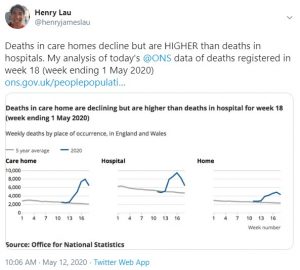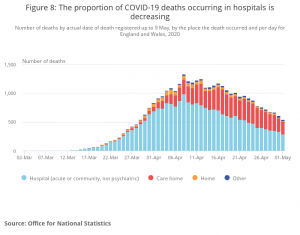The true death rate due to infection with Covid-19 has been a source of controversy ever since the government began its daily briefings and announcements of the daily death figures.
Initially, the government figures included only deaths in hospitals, then after some considerable amount of pressure, from 29 April the figures included deaths outside of hospitals, including in care homes, hospices and at home. But the figure still only includes those that have tested positive for the virus. As a result, many believe that the government’s figures are a significant underestimate of the death toll, which they believe to be well over 50,000 already.
On 12 May 2020, the ONS announced that 35,044 deaths were registered in England and Wales by 9 May with Covid-19 mentioned on the death certificates. With the addition of deaths in Scotland and Northern Ireland and the more recent deaths announced daily by the government, this takes the UK’s death toll to 40,011, the highest death toll in Europe from coronavirus.
Last week the UK became the worst-affected country in Europe, and these figures mean that this position continues. According to data collated by Johns Hopkins University, Italy has recorded 30,739 deaths, Spain 26,744, and France 26,604, Germany has recorded just 7,661 deaths.
Chris Giles of The Financial Times believes that the figures from the ONS of deaths due to Covid-19 are a considerable underestimate. Soon after the ONS publication on 12 May, the FT reported that excess deaths were above 50,000 and this is a better indication of the level of deaths due to the virus.
Excess deaths are those that are in excess of the five year average seasonal mortality reported by the Office for National Statistics (ONS). Chris Giles, Economics Editor for the FT, notes that the methodology uses the weekly figures released by the ONS of death registrations and the daily figures released by the government, and takes into account people who have died but not been tested for Covid-19, people who were unwilling or unable to get to hospital for some reason, plus effects of the lockdown (for example, increased domestic violence, but lower traffic accidents).
For the week ending 1 May, there were 8,012 excess deaths in England and Wales; this was the seventh consecutive week that deaths exceeded normal levels. After adding the equivalent figures from Scotland and Northern Ireland total mortality across the UK during the pandemic to 50,979, according to the FT model.
The last two weeks of figures from the ONS have shown just how great a toll the pandemic has taken in care homes around the UK. The normal level of death registrations for care homes in England and Wales at the end of April is just over 2,000, the figure reported by the ONS for the equivalent week, ending 1 May, was 6,409; this is more than three times the normal rate.
According to the ONS data deaths in care homes have begun to fall for the first time and the peak is likely to be past, but they are still higher than the deaths in hospital.

The ONS data (shown below) indicates that the proportion of deaths in hospital due to Covid-19 is decreasing and in recent days the proportion of deaths in care homes due to Covid-19 has risen to 40.4% of all deaths registered due to the virus.

It is now clear that the focus on hospitals and freeing up hospital beds has been a major error that has cost many lives. Carl Heneghan, professor of evidence-based medicine at Oxford university, criticised the decision to move infectious people into care homes when he spoke to the FT:“Clinically, it just doesn’t make any sense whatsoever to put a person with an active infection into a home setting where other people are in significant numbers and are vulnerable.”
Finally, last week in the 5 May press conference, the government seemed to acknowledge that there is an issue; Professor Angela McLean, the UK’s deputy chief scientific adviser, admitted that they need “to get to grips” with what is happening in care homes after noting that “whilst deaths in hospital have been falling, deaths in care homes in the week to 24 April were still rising.” Good that it has now been acknowledged, however this is far too late for those who have lost their lives due to the government’s policy early on in the pandemic.
Dear Reader,
If you like our content please support our campaigning journalism to protect health care for all.
Our goal is to inform people, hold our politicians to account and help to build change through evidence based ideas.
Everyone should have access to comprehensive healthcare, but our NHS needs support. You can help us to continue to counter bad policy, battle neglect of the NHS and correct dangerous mis-infomation.
Supporters of the NHS are crucial in sustaining our health service and with your help we will be able to engage more people in securing its future.
Please donate to help support our campaigning NHS research and journalism.


